Do modern Dodge muscle cars capture the magic harnessed by Big Willie Robinson?

- Share via
A stab of the throttle, and the rear tires break loose. A little more gas — really, just a little more — and you’re sideways.
In Hellcat guise, Dodge’s Challenger coupe and Charger sedan are true muscle cars: loud, heavy, unwieldy, scary, silly and, yes, extremely fast.
Dodge has hewed to the original muscle car formula, transforming relatively inexpensive (and tame) rides with the addition of high-performance V-8 engines cranking out more than 700 horsepower.
The performance is staggering: 0 to 60 mph comes in about 3.5 seconds, with a top speed of about 200 mph for both cars. It is Ferrari-like speed for a fraction of the price: For the 2019 models, the Challenger SRT Hellcat starts at around $61,000 and the Charger SRT Hellcat at about $67,000.
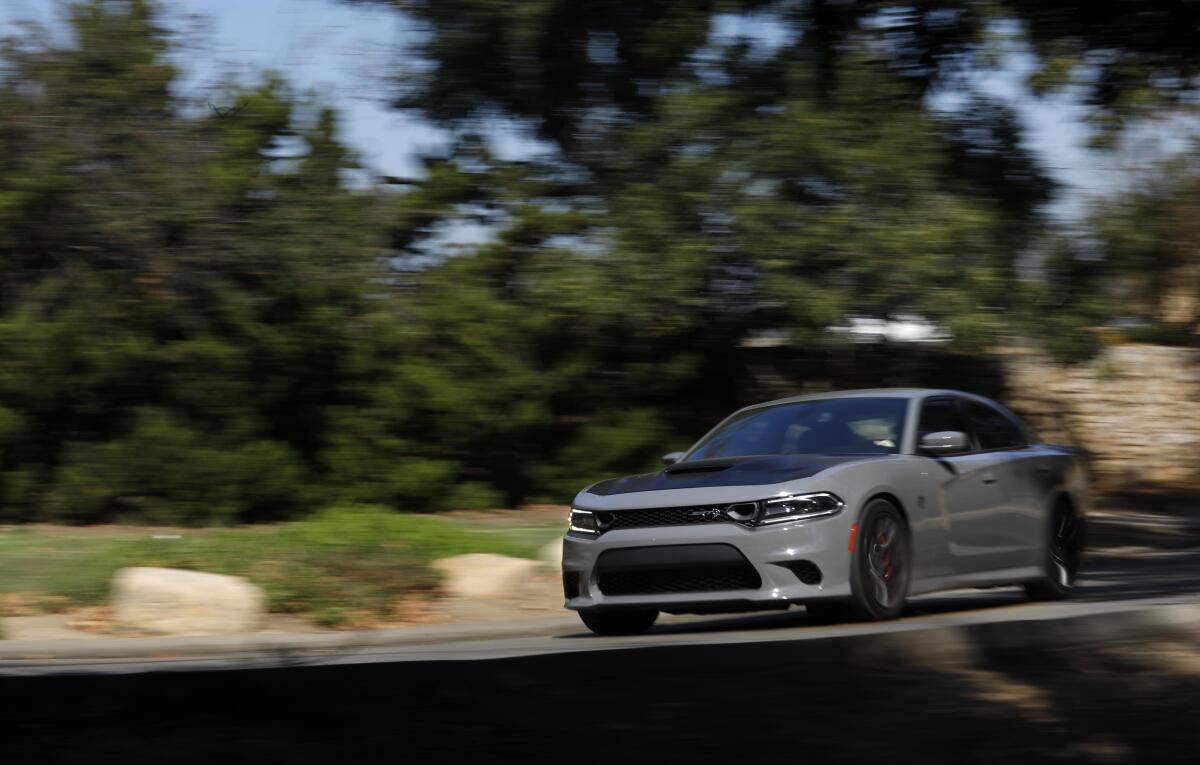
Dodge’s original muscle cars — like the 1969 Dodge Charger Daytona — were once drag strip mainstays, cementing the brand’s reputation among enthusiasts. Today’s performance would’ve been unfathomable back in the muscle car heyday of the 1960s, so I wondered, do these new vehicles contain any of the old Dodge DNA?
I was particularly curious about how the Hellcat models compared to the Daytona. That’s because it was the ride of choice of Big Willie Robinson, the subject of “Larger Than Life,” a seven-part podcast I hosted for The Times that documented the street racer’s effort to bring peace to an L.A. torn apart by the Watts riots.
“When you get around cars, man, there ain’t no colors, just engines,” Robinson told The Times in 1981.
Speed wasn’t always Robinson’s focus, but the car he drove was still exceedingly fast. And rare. Only 501 of the 1969 Daytonas were made — and they were “purpose-built to win NASCAR races,” according to Brandt Rosenbusch, manager of historical services for Fiat Chrysler Automobiles US, the parent company of Dodge. These days, examples can fetch more than $500,000 when they cross the auction block.
“The fact that Dodge was willing to bring out such a radical car with the expressed purpose of winning is amazing,” Rosenbusch said. “These are now one of the most collectible cars among enthusiasts.”
The one Robinson drove — he dubbed it the King Daytona — was especially rare. It was one of only a few dozen 1969 Daytonas built with a Hemi motor, whose hemispherical combustion chambers aid performance. Robinson’s wife, Tomiko, had a matching Hemi car she called the Queen Daytona.
This fall, I finally got the chance to compare the 1969 Daytona to its spiritual successors. Dodge lent me a 2019 Charger Hellcat (price as tested: $74,915) and a 2019 Challenger Hellcat Redeye ($91,169), a special version of the car that adds 80 horsepower for a total of 797.
Between the two Hellcat variants, the Redeye more closely resembles the 1969 Charger Daytona: Both are uncommon coupes that offer top-of-the-line performance from the brand. (However, in relative dollars, the Redeye is quite a bit more expensive than the 1969 Hemi Daytona, which cost around $5,600 new, or about $40,000 today.)
Few cars can compare to the go-fast looks of the Daytona, with its sleek nose cone and towering rear wing. Still, the Redeye signals it means business with dual hood scoops that, unlike so many modern cars, actually function, feeding the engine air.
Our tester came with a $6,000 widebody package that outfits the car with flared fenders that accommodate enormous Pirelli P-Zero tires paired with 20-inch wheels. A $3,495 graphics package swaths the hood, roof and trunk lid in matte black paint. The effect of these options is immense, transforming the car into something legitimately menacing.
Despite appealing touches like an 8.4-inch touchscreen that runs the intuitive Uconnect vehicle management system, the interior of the Redeye was a letdown. It is bathed in plastic that can feel cheap in places, and the front seats were squishy and unsupportive, betraying the car’s sporting nature. The dated interior points to the age of this iteration of the Challenger platform, which bowed in 2008.
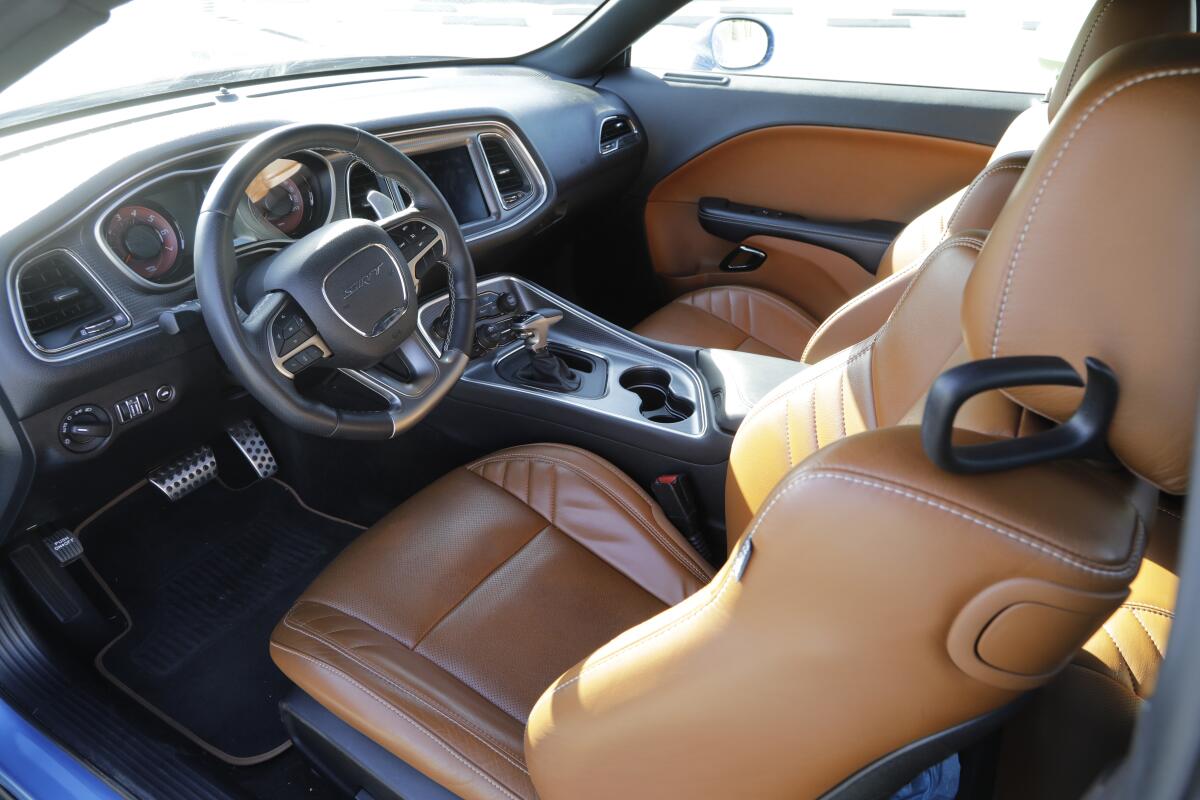
But there are touches that reveal a sense of fun — and even mischief. One amusing detail: The Redeye and the Charger Hellcat come with two keys, a black one and a red one. Use the black key, and you’ll be able to access only 500 horsepower. You’ll need the red one to unlock the car’s full potential.
The Redeye’s 6.2-liter V-8 does its share of barking and snarling, but it’s the high-pitched whine of the supercharger, which pressurizes air fed into the engine, that is the defining feature of the car’s aural character. The sound doesn’t immediately scream “muscle car,” but it is an aggressively mechanical one that I grew to appreciate.
Fifty years after the Daytona debuted, the Redeye offers, right off the showroom floor, performance for which Robinson and his ilk would have had to pay dearly.
Dodge clocks the Redeye’s quarter-mile, the traditional drag racing length, at 10.8 seconds. The August 1970 issue of Popular Hot Rodding described the King Daytona, which Robinson had souped up at Keith Black Racing Engines, a Hemi specialist then based in South Gate, as a “true low, low 12-second street machine.”
I couldn’t get any seat time in the late Robinson’s car — it was destroyed in 1971, and his wife’s matching car was wrecked a few years later. But I did track down a 1969 Hemi Daytona owned by car collector Greg Joseph.
Joseph actually knew Robinson; he met the leader of the Brotherhood of Street Racers in the 1990s via former Times Publisher Otis Chandler. At the time, Joseph was curating the muscle car collection of Chandler, whose holdings included a 1969 Hemi Daytona of his own.
Joseph said he was touched by the realization that he, Chandler and Robinson and his street racer wife each owned one of these unique rides.
“They truly were icons,” Joseph said. “It kind of brings back the nostalgia, the memories of the time when I went to all the drag races.”
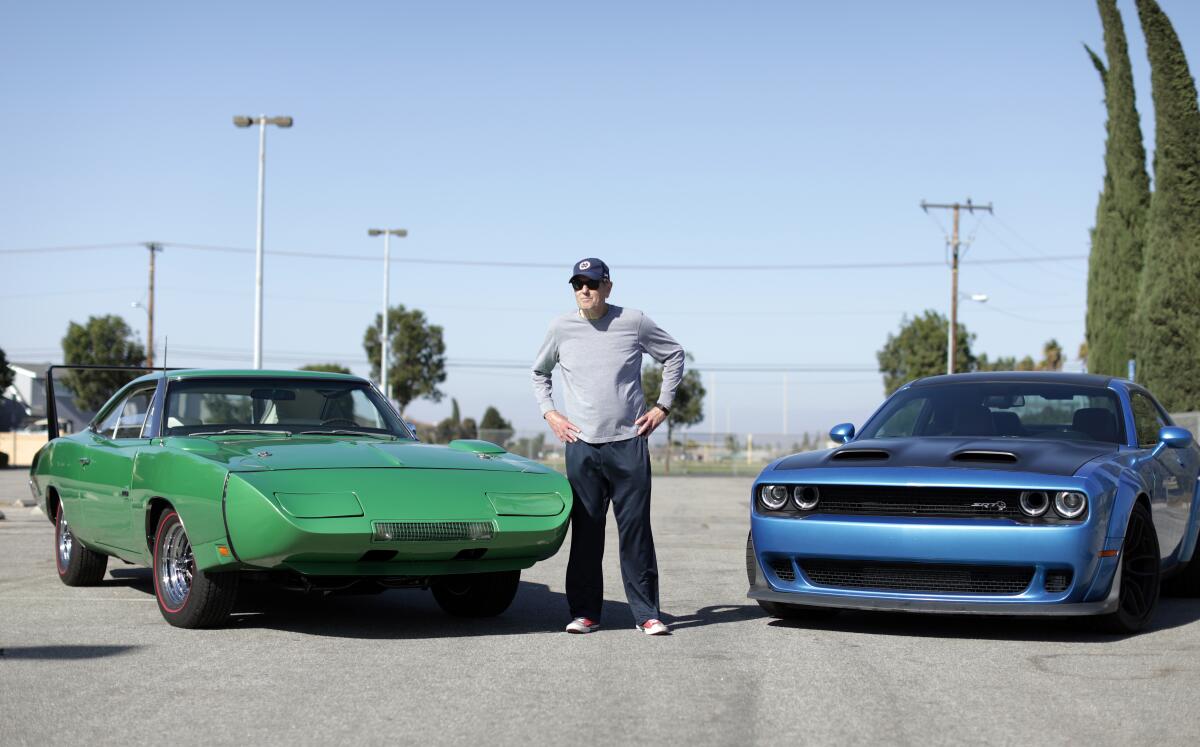
Joseph, a retired history professor who long taught at Long Beach City College, said he sees the through line from the Daytona to the Redeye, in part because both harness what he called “state-of-the-art technology to go fast.”
“This is all-out high-performance,” said Joseph, gesturing at the Redeye. “Same with the Daytona.”
Still, the Redeye isn’t entirely state-of-the-art. It derives its power from a pushrod V-8 — that’s old-fashioned technology in an era of overhead cam motors with variable valve timing — but I get Joseph’s point. This is a car whose launch can be programmed via a special mode that holds the RPM at a desired spot in the power band for optimal acceleration.
And the Redeye carries over other technology from the 2018 Challenger Demon, an even higher-performance version of the car that put out 840 horsepower — and did zero to 60 in 2.3 seconds — but was sold for only one year. Among the goodies that have found their way from the Demon to the Redeye is an intercooler chiller system that keeps the motor at the ideal temperature.
Although the Redeye was the more extreme of the two cars I tested, the Charger Hellcat seemed to turn more heads during the week I drove it. As with the Challenger, this version of the Charger has been around for several years, but in Hellcat guise, the exterior modifications stand out. Perhaps that’s because they’re transforming a sedan with comparably more sedate looks.
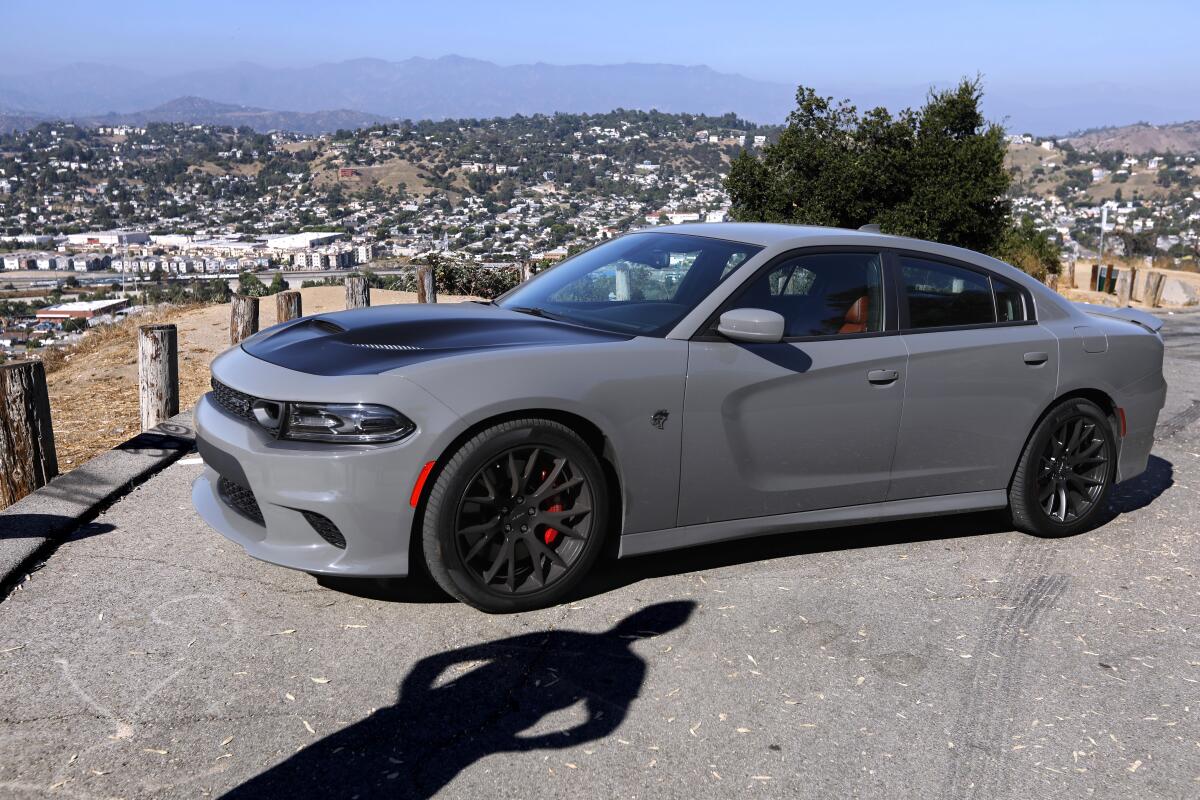
At one stoplight, a man in a black minivan eyed the Charger Hellcat lustily from the neighboring lane. I edged the car forward, summoning a bark from the big V-8, and the other driver laughed appreciatively. Up the street, our lanes merged into one, and he happily ceded the road.
The minivan may have been no match for the Charger Hellcat, but the American muscle car rivalry is alive and well. And in many ways — even as manufacturers move toward increased electrification and hybridization — we are in the midst of a new golden age for these vehicles. A horsepower war touched off by the launch of the 2015 Challenger and Charger Hellcats shows no signs of slowing down. Chevrolet’s Camaro ZL1 offers 650 horsepower, and Ford is readying a top-end Mustang — the Shelby GT500 — packing 760 horsepower.
The Hellcat cars both deliver a quintessential muscle car ride. But it wasn’t easy for me to see a link to the Dodge drag strip heroes of yore, amid the many trappings of modernity.
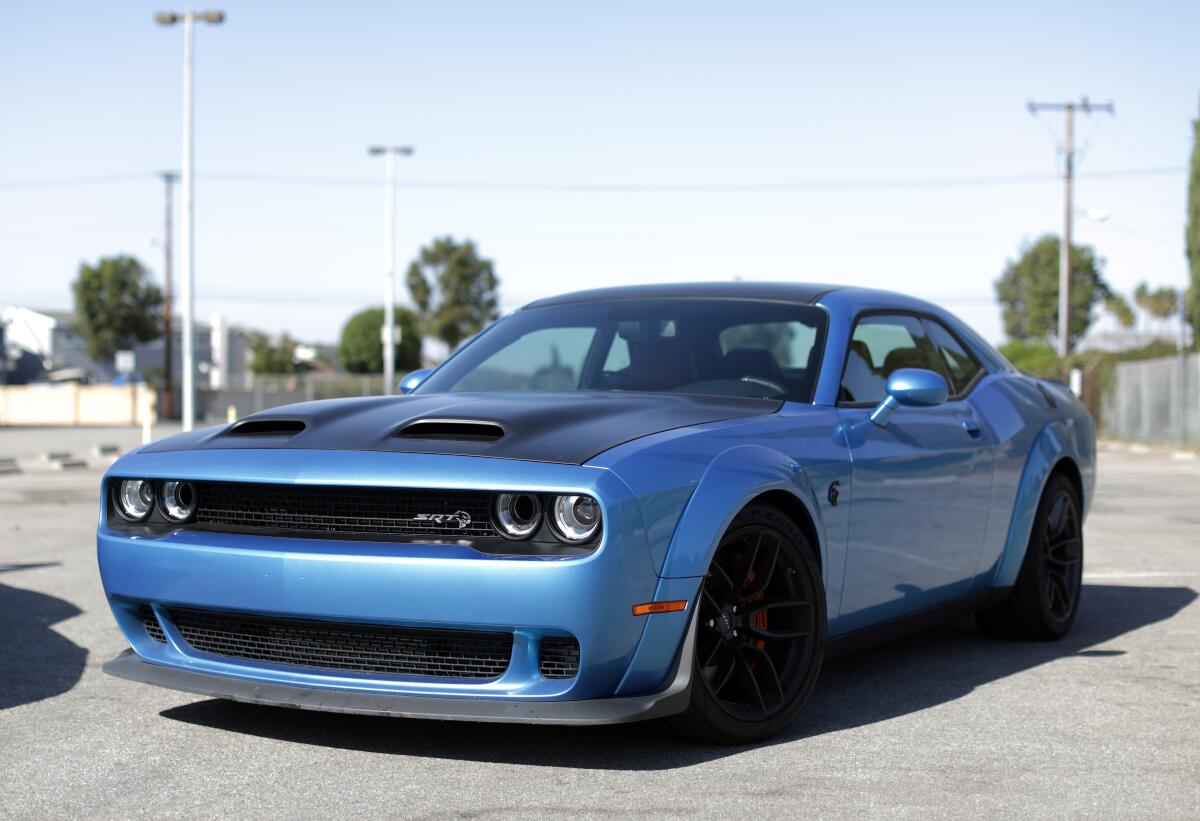
Still, I was able to find a connection to the past in an unexpected place: some of the new cars’ shortcomings. Details like the Redeye’s subpar seats — yielding in all the wrong places — seemed to telegraph Dodge’s focus on speed, and little else. Thinking about the Hellcat cars this way, I grew to view many of their flaws as charming. And the ties to the 1960s were ultimately driven home via a mishap.
Before the Redeye was lent to The Times, it underwent some mechanical work that left the interior smelling of gasoline. Workers had attempted to mitigate it, but the bouquet of fuel stubbornly persisted.
But it didn’t bother me. It felt a little rough, a little raw. Like how old cars sometimes smell after they’ve been throttled hard.
Even if it was unintended, it made the Redeye feel a little bit closer to 1969.
A little bit closer to the Daytona. A little bit closer to Robinson.
2019 Dodge Charger SRT Hellcat
Times’ take: Prodigious power in a family friendly package
Highs: Good value for the performance delivered
Lows: Interior materials are lacking
Vehicle type: Four-door, five-passenger sedan
Base price: $67,495
Price as tested: $74,915
Powertrain: 6.2-liter, eight-cylinder, supercharged gasoline engine
Transmission: Eight-speed automatic, rear-wheel drive
Horsepower: 707
Torque: 650 pound-feet
Estimated fuel economy rating: 13 miles per gallon city / 22 highway / 16 combined
2019 Dodge Challenger SRT Hellcat Redeye
Times’ take: The ultimate American muscle car
Highs: Truly menacing looks, and performance that lives up to them
Lows: Options quickly add up to a pricey ride
Vehicle type: Two-door, five-passenger coupe
Base price: $71,945
Price as tested: $91,169
Powertrain: 6.2-liter, eight-cylinder, supercharged gasoline engine
Transmission: Eight-speed automatic, rear-wheel drive
Horsepower: 797
Torque: 707 pound-feet
Estimated fuel economy rating: 13 miles per gallon city / 22 highway / 16 combined
More to Read
Inside the business of entertainment
The Wide Shot brings you news, analysis and insights on everything from streaming wars to production — and what it all means for the future.
You may occasionally receive promotional content from the Los Angeles Times.










